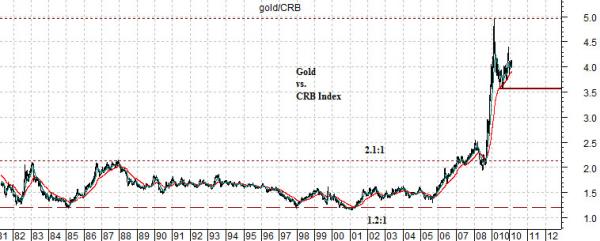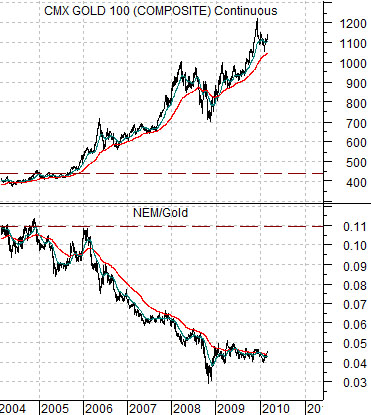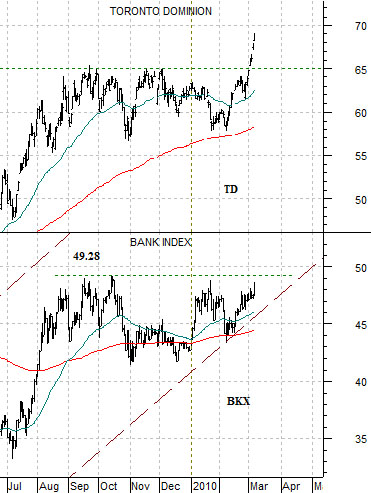Our focus in recent days has been on the slope of the yield curve, the lagged impact on the share prices of the banks, and the potential for lower gold prices. We should note, however, that the major banks are just one of the cyclical sectors that stand to benefit. We are most certainly not arguing that the banks are the only group that could trend higher; the point is and has been that downward pressure on the major financials has been one of the main factors responsible for the rush to safety that helped propel gold prices to current levels.
Below is a fairly simple chart of the ratio between gold futures prices and the CRB Index from 1981 to the present time period.
The chart shows that between 1981 and 2007- a span of 26 years- the ratio between gold and general commodity prices ranged from around 1.2:1 at the bottom and 2.1:1 at the top.
One could argue that gold prices were artificially depressed by producer forward selling, central bank gold lending, or some kind of nefarious government plot to frustrate the gold bulls. One could argue that the explosion in both absolute and relative gold prices was simply the result of a market coming back ‘on trend’ after years of manipulation and neglect. Once could but… we choose not to today.
Our point is that the ratio does not measure the price of gold relative to stocks, the dollar, bonds, or even cash. It shows the ratio of gold prices to commodity prices. Apples to apples, in a sense.
Over time money has rampaged into one market or another before exiting as prices collapse. One of our views is that absolute conviction is a double-edged sword as this kind of certainty is necessary to ride the trend all the way up even as it carries investors over the top and down the other side.
From our perspective there are at least three factors that support gold prices. First, the weaker U.S. dollar. Second, declining interest rates. Third, the potential for major financial institutions to disappear combined with the ‘whatever it takes’ approach to the assorted crises by central banks.
While we know that we will never dent the convictions of the true believers our thought is that if a weak dollar, falling interest rates, and imploding bank stocks helped lift gold prices higher… then isn’t it possible that a stronger dollar, rising interest rates, and rapidly recovering banking system profits will serve as a negative? With the CRB Index currently trading under 280 a return to a ratio between 1.2:1 and 2.1:1 suggests at the least the potential for much lower gold prices in the days to come.

Equity/Bond Markets
At top right we show a comparison between 3-month U.S. TBill yields and the U.S. Dollar Index (DXY).
The chart suggests that around the end of November last year something changed. As the dollar began to recover the trend for short-term U.S. interest rates began to rise. We accept the argument that an increase from .02% to .145% is hardly a momentous change and that we have no need to worry about an increase in the Fed funds rate until TBill yields rise above .25% but… a trend has developed that includes both dollar strength and higher interest rates.
Below right is a comparison between the share price of Canada’s Toronto Dominion (TD) and the Bank Index (BKX). The argument has been that the Cdn banks will lead to the upside so the series of price break outs in this sector suggested that better day may lie ahead for the U.S. banks.
Below is a comparison between gold futures and the ratio between the share price of gold miner Newmont (NEM) and gold prices.
In a speculative and overheated market the price of the gold miners will rise faster than the price of gold. In other words the NEM/gold ratio would be trending higher as gold prices improved.
This has obviously not been the case since the start of 2006. The price of gold has risen not only relative to the equity markets in general but also to the gold miners in particular. That, we would suggest, is the mark of a trend away from risk and towards safety.
The ‘3-year lag’ argument suggested that the cyclical trend turned negative in 2006 and returned to positive in 2009. If so then the gold miners would be expected to at least outperform gold prices over the next few years.






